|
WAR’S END AND BEYOND
June –
November, 1945
Credit
A lot of gratitude towards WW2 D Battery Mr.
Ken HESLER for research and writing.
Introduction
Although the war had not ended, the 463rd Parachute Field
Artillery Battalion’s final fire missions were April 17, 1945, at
Neuss, Germany. After several interim tactical moves with no further
enemy contact, the 463rd established a Command Post in the city of
Thalham and was assigned the role of Police and Military Government.
Hitler’s mountain top retreat at Berchtesgaden fell to the 101st
Airborne Division May 5, 1945, with the war officially ending three
days later. For the Battalion, it was then on to Bad Reichenhall, a
spa town in Upper Bavaria in a scenic alpine setting where it would
continue its occupation duties for about six weeks before moving on
to Saalfelden, Austria, July 8. It was relieved of all security
duties at the end of July. Its final major move in the ETO was to
Joigny, France, where it would remain until inactivated along with
the rest of the 101st at the end of November 1945.
Occupation security involved a wide range of duties–serving as a
local police force, maintaining road blocks to control the movement
of civilians, guarding dumps of military supplies and
enclosures of displaced persons, and protecting an art collection
located in a castle, among others. Details of the 463rd activities
from June through October, 1945, are spelled out in the Battalion’s
official monthly narratives that follow this introduction.
The postwar period for the 463rd in Europe was profoundly
affected by several factors. According to a Turner Publishing
Company history of the 101st Airborne Division produced in 1995 for
the 101st Airborne Division Association, the Screaming Eagles
learned in June 1945 that they would be moving to the Pacific. This
followed an earlier announcement by Gen. Maxwell Taylor, Division
commander, at a Division formation while at Mourmelon in March that
he was “doing all in my power to have the Division sent to Japan,” a
statement roundly booed by those in the formation. Prior to the
surrender of the Japanese, the 463rd conducted a summer training
program for redeployment to the Pacific through August and the first
week of September, including instructions in Japanese tactics,
techniques, and background.
It was then announced, “that the Division was to proceed to the
United States as part of the general reserve” with the 82nd Airborne
Division to be inactivated.” Later, the Army reversed that decision,
with the 101st being the “one destined to be inactivated there in
France.” Steven Mrozek, author of the “82nd Airborne Division,”
writes that “There was some concern in late summer that the 82nd ABN
Div would be deactivated. Through some strong influence in high
places, the division was chosen as the airborne division that would
remain intact in the post war Army.” The 101st would be inactivated
November 30, 1945, in France.
While all of these things were occurring, the Advanced Service
Rating Score (ASR point system) was being put into high gear
following the victory in the ETO. Rumored since 1942 in North
Africa, the “rotation” plan had been introduced first in the fall of
1944 and revised twice in the spring of 1945. Simply put, the
soldiers with the longest service in the U.S. and overseas and
having been awarded more medals and battle stars were to have the
most points and go home first. The minimum required point total for
enlisted troops to return to the United States was 85. Until the war
neared its end, that issue had been a mute one for those signed to
serve “the duration plus six months.” In the spring of 1945, it came
to the forefront.
The ASR point total was determined by adding together for each
soldier one (1) point for each month of service since September 16,
1940; one (1) point for each month service overseas; five (5) points
for each combat award, including medals and battle stars; and twelve
(12) points for each child up to three under the age of 18. No
points were awarded for age or marriage. Officers were judged
separately on points, military efficiency, and specialties.
With the Division awaiting assignment to the Pacific while at the
same time losing many of it long-time members with more than 85
points, replacements with lower ASR points were flowing in from
other airborne units in the ETO, particularly the 17th Airborne
Division. Thus, soldiers with ASR scores below 85 with the 17th
might be transferred to the 463rd in the 101st and then, possibly,
be transferred again to the 82nd for occupation duties in Berlin,
compiling a record of service in three airborne divisions within a
brief period of time. One result of this constant departure of 463rd
troops and the arrival of replacements was the need for a constant
training program to fill out the roster of vacated positions.
The last narrative is dated November 9, 1945 for the previous
month and reports an increasing number of soldiers transferred to
other units and replacements depot centers for movement to the USA.
The 463rd, along with the 101st Airborne Division, was inactivated
on November 30, 1945, with a final group transferring to the 82nd
Airborne Division. Ironically, they were transferred to the 82nd’s
456th Parachute Field Artillery, the same unit with which some had
trained at Fort Bragg in 1942 before being shipped overseas in 1943
and from which the 463rd was later organized on the beachhead at
Anzio, Italy, in 1944. This final group came home on the Queen Mary,
departing Southampton, England, on December 28, 1945, arriving in
New York January 3, 1946. On January 12, 1946, they marched in the
World War II Victory parade up New York City’s Fifth Avenue.
Pictures at Bad Reichenhall
Courtesy : Mr. Jim Growney
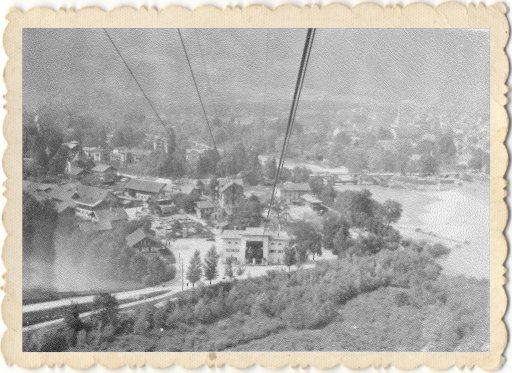 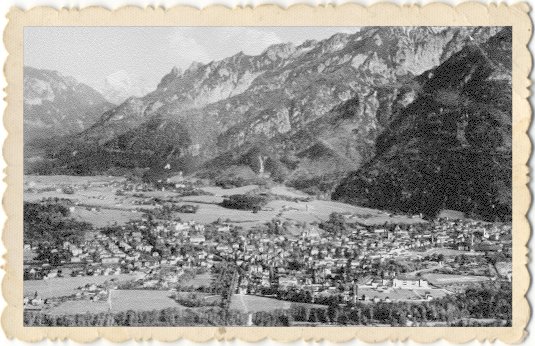
View on Bad Reichenhall
Courtesy : Mrs. Kristy Hazzard
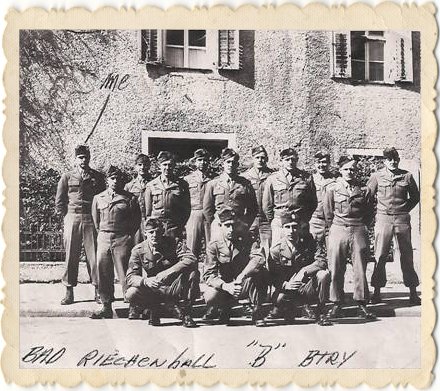
B Battery at Bad Reichenhall
Gus Hazzard Photo ("Me")
From the book "Epic of the101st Airborne", 101st
Airborne Division, Auxerre, France, 1945
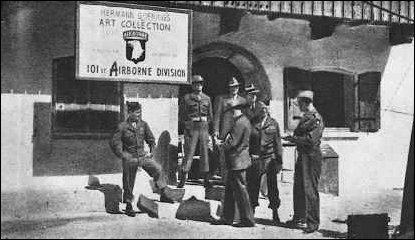
101st Airborne Division
soldiers guard
the captured art collection of Hermann Goering,
Commander-in-Chief
of the German air force,
in the small Bavarian village of Unterstein.
|
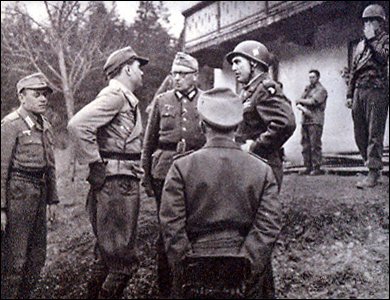
Col. Robert Sink, 506th
Parachute Infantry Regiment (wearing helmet), talks with Lt.
General Theodor Tolsdorff of the German Army
following his capture in May 1945.
|
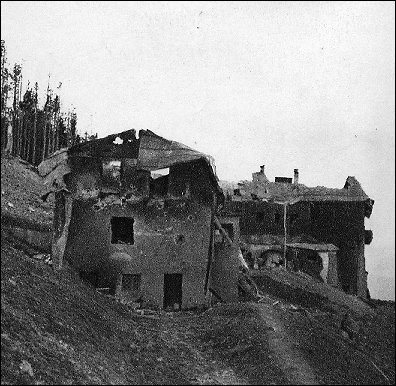
Remains of Hitler’s
mountainside home,
the Berghof,
above the Bavarian town of Berchtesgaden,
at the close of World War II.
|
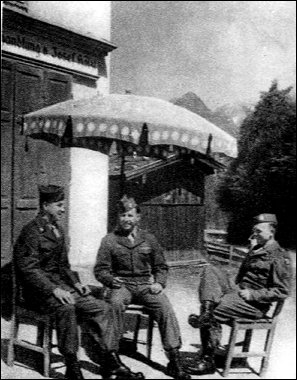
Three Screaming Eagles enjoy
the summer sun in Bavaria, Germany, while on occupation
duties in 1945. |
Reports from June - November 1945
|
HEADQUARTERS
463RD PARACHUTE FIELD ARTILLERY BATTALION
APO # 472 US ARMY
10 July 1945
SUBJECT: Historical Record for period 1 - 30 June 1945.
TO : COMMANDING GENERAL, 101st
Airborne Division, APO # 472, US ARMY.
(Attn Division Historian)
MAPS: Map of Germany, 1/100,000. Sheet Y-7. Bad
Reihenhall.
The battalion carried out those security missions
assigned by higher headquarters, and in addition took such
security measures as seemed to be required by the local
situation. Most of these missions and measures took the form
of read blocks designed to control the movement of
civilians, and guards upon dumps of military materiel,
Specifically, road blocks were maintained at (87.3-18.1),
(87.0-19.0), and (79.9-13.0) intermittently from 17 June to
28 June 1945. During the same period a guard was maintained
upon a displaced persons enclosure at the Oberschule in Bad
Reichenhall, and upon a dump of Germany signal equipment at
(86.4-20.0). Throughout the month the battalion policed the
town of Bad Reichenhall, and the police force detailed to
this work had the maintenance of security as one of the
missions. No insurrection of Werewolf activities were
reported during this period.
A training schedule was carried out during the morning
hours with the aim of maintaining a reasonable standard of
efficiency in combat duties. Familiarization courses were
fired with individual weapons. Physical conditioning was
emphasized with regular periods of calisthenics, and with
progressively longer and faster road marches. In view of the
anticipated large seals replacement of the personnel of the
battalion a training program of non-commissioned officers
replacements was instituted. Candidates for non-commissioned
officers replacement understudied incumbent first four
graders. As the candidates for positions became sufficiently
well acquainted with the duties they might be expected to
perform, they were required to occupy the positions and
carry on the work full time under the supervision of the
incumbents and of the officers who usually supervised the
sections. Additional features of the battalion training
program were instruction in the operation of the 75
recoilless rifle, and a series of venereal diseases led by
the battalion surgeon, a chaplain, and an officer in the
chain of command. Also , two hours each week were spent in
instruction in Japanese tactics, techniques, and background.
Morale was high during the month, with many of the man
anticipating a speedy return to civilian life after long and
arduous service.
Special Service carried on an athletic program during
the afternoon hours. Regular inter-battery competition was
organized in softball and volleyball. A battalion track team
was trained, and it defeated the other artillery battalions
in a division artillery track meet. Subsequently, members of
the battalion team performed creditably on the division
artillery team. Men from this battalion also won places on
the division artillery boxing and baseball teams.
The battalion Information and Educational program was
enlarged during this period. In addition to two hours weekly
of orientation discussion of topics of general interest,
daily classes were offered in spoken French and German under
a qualified civilian instructor. On-the-job training in
automobile mechanics was provided for twelve selected
students.
The non-fraternization policy was still been followed quite
effectively. One case of fraternization was reported. One
enlisted man was found talking to a German woman. The only
action taken vas a verbal waning since the report was
received just prior to the transfer of the man to another
unit for redeployment. The venereal rate was up over that of
the previous month. However it began to decrease the latter
part of the month.
The transportation of displaced persons from Bad Reihenhall
continued during the mouth of June. On 8 June twenty seven
(27) DP's were sent to a displaced persons camp at
Berchtesgaden, Germany. this number was composed of sixteen
(16) Frenchmen, two (2) Belgians, three (3) Dutchmen and six
(6) Luxembourgeois. Two hundred and fourteen (214) Russians
were sent to a DP railhead at Shladring, Austria, on 13
June. On 21 June forty nine (49) DP's were sent to a
displaced persons camp at Salzburg, Austria, The composition
of this group was twenty seven (27) Czechs, eleven (11)
Italians, seven (7) Frenchmen, three (3) Belgians, and one
(1) Dutchman. This made a total or six hundred and fifty
(650) DP's that have been sent from Bad Reichenhall during
the period of month and a half that this battalion has
occupied the town. Very few displaced persons now remain in
the town.
No discoveries of important treasures, documents, or war
criminals have been made in this area during the month.
No German prisoners were discovered or captured, nor were
any German supplies found during the month. A drive was made
to clear the battalion area of all German smoke drums of
which there were quite a few. The drums were emptied of
their contents and stored is dumps in the battalion area.
This drive was completed by the 27th of the month.
During the month the battalion received word from the
division that it was is Category II and would therefore be
transferred to the Pacific in due time.
A large change of personnel took place during this period
due to redeployment. On 6 June Lt Col JOHN T. COOPER, the
Battalion Commander was transferred to the 16th
Reinforcement Depot. Lt Col COOPER was one of the first two
officers of the 101st Airborne Division to be sent back to
the United States for redeployment or discharge. Fifty (50)
enlisted men were also transferred to the 16th Reinforcement
Depot at the same time for redeployment. This group was
composed largely of key non-commissioned officers of the
battalion. All men had 106 points or more. Major STUART M.
SEATON assumed command of the battalion upon Lt Col Cooper's
transfer. On 13 June six (6) enlisted men with over 105
points were transferred to Reception Stations is the United
States far redeployment or discharge. One hundred and thirty
four (134) enlisted men were transferred to the 82nd
Airborne Division on the 27th of June, These men had fought
is both the Mediterranean and European Theaters, had less
than 85 points, and did not volunteer for the Pacific. On 29
June 1945 two hundred and seventy nine (279) enlisted men
and seven (7) officers were transferred to the 501st
Parachute Infantry for redeployment to the United States and
probable discharges. 0n 30 June 1945 one hundred and ninety
nine (199) enlisted men were received from the 17th Airborne
Division as reinforcements to replace the men lost by
redeployment. Ninety-four (94) enlisted men, who had fought
is both theaters, and who had less than 85 points and who
were therefore eligible for transfer to the 82nd Airborne
Division volunteered to remain with the battalion and go to
the Pacific.
The battalion remained billeted is the town of Bad
Reihenhall during the month of June.
KENNETH L. BOOTH
Lt Col. F.A.
Commanding
|
|
HEADQUARTERS
463rd Parachute Field Artillery Battalion
APO 472 US ARMY
9 August 1945
SUBJECT: Historical Record for period 1 - 31 July 1945.
TO : Commanding General, 101st
Airborne Division, APO 472,
U.S. Army. (Attention: Division
Historian).
MAPS: Map of Germany, 1/000,000, Sheet Y-7, Bad
Reichenhall and Sheet Z-7, Bruck.
Map of France, 1/50,000, Sheet 11 H/4, Joigny
The battalion continued to carry
out security missions in the Bad Reichenhall area until
070800 July when it was relieved by the 431st AAA-Battalion.
On 8 July this Battalion relieved the 3rd Battalion 506th
Parachute Infantry Regiment of the security responsibilities
in the Saalfelden, Austria area (95-82). These security
missions included both road blocks and German dumps. Road
blocks were maintained in Austria at Alm, Rosenthal and
Saalfelden until 10 July when the 321st Glider Field
Artillery Battalion assumed the responsibility for them. A
food warehouse located near the railroad station in
Saalfelden and an art collection located in a castle near
Saalfelden were turned over to the 321st on the same date.
On 11 July the battalion again assumed the responsibility
for the art collection, On 8 July the battalion assumed the
responsibility for a German ammunition dump and a warehouse
with numerous types of German equipment. Prior to 29 July
all of the signal equipment and Class 8 supplies had been
moved from the warehouse to different corps dumps. No
Werewolf activities were reported for the period.
Special Service carried on an athletic program during the
afternoon hours. Inter-battery competition in softball and
volleyball was reorganized after the battalion had exchanged
about 80% of its personnel for reinforcements. In softball
"D" Battery emerged as the outstanding team and represented
the Battalion in the division artillery league. The officers
defeated "C" Battery and "D" Battery and was undefeated by
other officer teams. Pfc. Albert J. Towar Jr. of "D" Battery
won a place on the division swimming team. In the Third Army
meet at Nurnberg on 28 July Pfc Towar placed fourth in the
400 meter event and was anchor man on the 800 meter relay
team that placed second, Pvt. Harry Rubin and Pfc. Steve
Osga represented the battalion on the division boxing team.
In the II Corps boxing tournament at Zell am See on 28 July
Pvt. Rubin won by a KO in the first round while Pfc Osga
lost a close decision.
The instruction phase of the battalion Information and
Education program was suspended because of the institution
of a full time training program. However the guidance phase
was enlarged accordingly. Men new to the battalion were
interviewed to discover their educational needs and desires.
During the month seven (7) new applications for USAFI
correspondence or self-teaching courses four (4)
applications for Army University Centers, and twelve (12)
applications for civilian educational institutions were
processed and forwarded. Orientation discussions were
continued two hours each week, with special attention given
to the maintenance of moral by the unrestricted airing of
grievances so that they might be acted upon and eliminated.
Moral was generally high during the month in spite of the
uncertainty of the future, and a natural reluctance to
resume a full time training program.
No cases of fraternization were reported prior to 15 July
at which time the non-fraternization ban was lifted. Altho
the battalion seemed happier after the lifting of the ban no
great change toward fraternization was noted. Most of the
men know the enemy for what he is.
The Veneral rate in the battalion took a decided drop
during this period. Only four (4) new cases were reported
for the month where in the previous month there had been
fifteen cases reported. The drop is felt due in part to an
intensive campaign to decrease the VD rate in the battalion.
Some sixty (60) Hungarians were moved from the Bad
Reichenhall area on 3 July. This brought the total number of
DP's moved out of the Bad Reichenhall area by this battalion
to seven hundred and ten (710). No DP's were moved out of
the Saalfelden area by this battalion.
A castle at Saalfelden held a valuable art collection
from a museum in the city of Salzburg, Austria. This
battalion relieved the 3rd Battalion, 506th Parachute
Infantry Regiment of the guard of this collection on 8 July.
A guard of three (3) enlisted men was posted on the
collection at this time. On 10 July, this post was turned
over to the 321st Glider Field Artillery Battalion. On 11
July the post was again taken over by this battalion. At
this time an officer was added to the guard. The officer
acted as a guide for officers who were authorized by the
Commanding General, 101st Airborne Division Artillery, to
see the collection, This was to prevent theft or damage to
the collection.
A German PW camp and discharge center was operated by the
battalion in the Saalfelden area from 8 July until the 26th
of July when this battalion was relieved by elements of the
42nd Division. Most of the PW's were eligible for discharge
and some 3857 were discharged by an officer from the
Division IPW team during the period that the battalion
operated the camp . Two hundred (200) of these PW's were
non-nationals. Some fifty (50) were from the British and
Russian zones. Three hundred and six (306) were members of
the SS who were confined to an SS stockade located at the
camp. The battalion used these PW's to a great extent in
preparing athletic fields, police of the area, and work in
the German warehouses and ammunition dump.
On 1 July Lt. Col. Kenneth L. Booth, 0-24519 and four (4)
other officers, formerly of the 466th Parachute Field
Artillery Battalion of the 17th Airborne Division, joined
the battalion as re-enforcements for officers lost through
redeployment. Lt. Col. Booth assumed command of the
battalion this date. On 3 July five (5) officers and two
hundred and thirty-two (232) enlisted men from the 17th
Airborne Division were transferred to this battalion as
re-enforcements for the losses incurred through
redeployment. On the same date five (5) officers from the
battalion were transferred to the 17th Airborne Division on
redeployment. On 25 July the battalion transferred
twenty-eight (28) enlisted men to the 16th Replacement Depot
for redeployment.
On 8 July the battalion moved from Bad Reichenhall,
Germany to Saalfelden Austria (95.2-82.8). The battalion
closed in the new area at 1430.
An advance detail of six (6) officers and eleven (11)
enlisted men left Saalfelden by motor convoy for France on
21 July. This detail arrived at Joigny, France at 1630 on 23
July. This detail took over the installation of then 460th
Parachute Field Artillery Battalion which was part of the
13th Airborne Division. On 28 July this battalion was
relieved of all security missions by elements of the 42nd
Division. On 30th July the battalion started it's move from
Austria to France. The battalion was divided into two groups
for the move. The group moving by rail was commanded by
Major Seaton while the group moving by motor was commanded
by Captain Laidlaw. The rail movement was composed of eight
(8) officers and two hundred and twelve (212) enlisted men
in nine (9) personnel cars and left Saalfelden at 0900
hours. Nine cars were used to carry baggage. The motor
convoy was composed of fifteen (15) officers, one hundred
and eighty (180) enlisted men and fifty-five vehicles. The
motor convoy was divided into three march units and left
Saalfelden at 1812 hours.
KENNETH L. BOOTH
Lt Col. F.A.
Commanding
|
|
HEADQUARTERS
463rd
Parachute Field Artillery Battalion
APO 472 US ARMY
8 September 1945
SUBJECT: Historical Record for period 1 - 31 August 1945.
TO : Commanding General, 101st
Airborne Division, APO 472,
U.S. Army, (Attention: Division
Historian).
MAPS : Map of France, 1/50,000, Sheet 11 H/4, Joigny.
A training program was carried
out during this period with the aim of training the
battalion for redeployment to the Pacific. Most of the
battalion completed qualification and familiarization firing
of the carbine and pistol. One week was devoted to airborne
training with the aim of maintaining a reasonable standard
of efficiency.
The Red Cross held a number of
dances for the men of the battalion. Most of the men in the
battalion attended and enjoyed them very much.
Special Service carried on an
athletic program in the afternoons. Inter-battery
competition in softball and volleyball was continued. The
battalion softball team held down fourth place in the
Division Artillery League with one win and five losses. The
officer's softball team had better luck and placed second in
the Joigny Area Softball League with four wins and one loss.
The battalion baseball team did very well by placing fourth
in the division league with four wins and five losses. This
team is one of the few battalion teams in the Division
League. Most of the teams are on a regimental level. All of
the above standings are for the first half of the season.
Five men from this battalion were on the first team of the
division artillery baseball team which had priority over the
battalion team. Men from this battalion are also represented
on the division artillery football team and also the
division football team.
Three men from the battalion
were on hand for the Division Boxing Elimination Tournament
held in Joigny, France on August 16th, 17th, and 18th.
S/Sgt. Joe DeGraff had to forfeit his semi-final bout due to
a physical disability. Pvt Harry Rubin lost his semifinal
bout by a decision while Pfc Steve Ozga lost his final bout
by a close decision.
The instruction phase of the
Information and Education program remained suspended as the
battalion continued a full time military training program.
However, after the surrender of Japan preparations were made
to establish command unit schools at the earliest date that
authorization could be secured for the ending of full time
military training. A new survey was conducted of the
educational needs and desires of the battalion personnel,
and possible instructors were screened and their
qualifications investigated. Lt Ivan J. Wermuth was sent to
attend the General I & E Course offered by the 6819 ALESS at
Oberammergau, Germany. Enrollments in the United States
Armed Forces Institute were encouraged and four (4) new
applications were processed. Applications for educational
opportunities outside the unit were also processed and
forwarded, six (6) for Army University Centers, and eleven
(11) for Centralized Technical Schools. During this period
some of the applications of previous months bore fruit.
Captain Thomas F. Magner left the unit to attend a two-month
course in Modern French History at Besancon, France. Pvt
David Althouse and T/4 Edward J. Weisse went to the Army
University Center at Biarritz, France to study Pre-Medicine
and Commerce respectively. Pfc Sigurd R. Sigurdson resumed
his civilian speciality of Pharmacy at a civilian school in
England. Pvt Herbert B. Beverly and Pvt Rond G. Hagaman were
selected to attend the American Technical School at Warton,
England to study Aircraft Engines and Maintenance.
Orientation discussions were
continued two hours each week. Morale was generally high
during the month and the surrender of Japan auguring
speedier separation from the army than had been hopes for
before. Pass and furlough quotas were increased considerably
during the month and many men were receiving their first
pass or furlough in well over a year.
The first of August found the
battalion on the move from Saalfelden, Austria to Joigny,
France (76-40, Nord de Guerre Zone). The motor convoy
arrived at Joigny on 1 August 1945 while the group traveling
by train arrived on August 2nd. The battalion closed in the
Joigny Area at 1200, 2 August 1945.
On 19 August 1945 one hundred
and three (103) enlisted men with less than 85 points, and
seven (7) officers with more than 85 points were transferred
to this battalion from the 17th Airborne Division. On the
same date three (3) enlisted men with over 85 points were
transferred from this battalion to the 17th Airborne
Division for redeployment and discharge.
A detachment of one (1) officer and fifty-five (55)
enlisted men traveled to Brussels, Belgium as part of a
division detachment for the celebration of the liberation of
that city.
KENNETH L. BOOTH
Lt Col. F.A.
Commanding
|
|
HEADQUARTERS
463rd
Parachute Field Artillery Battalion
APO 472 US ARMY
6 October 1945
SUBJECT: Historical Record for period 1 - 30
September 1945.
TO : Commanding General, 101st Airborne Division, APO 472,
U.S. Army, (Attention: Division Historian).
A training program was carried out the first week of the
month with the idea of training the battalion for
redeployment to the Pacific. On the 10th of the month a
program of I & E courses was substituted for the morning
period from 9 to 12. The afternoon periods were allotted to
an athletic program. A training program was carried out for
the men not attending the I & E School. Four hours per week
were spent in unit tactical training in an effort to
maintain a reasonable standard of efficiency.
The Red Cross held two dances for the men of the battalion.
Most of the men in the battalion attended and enjoyed
themselves very much.
An afternoon athletic program was carried out by the
battalion. Inter-battery competition in softball and
volleyball was continued. The battalion softball team ended
the season in fourth place in the Division Artillery
Softball League with one (1) win and five (5) losses. The
battalion baseball team ended the season in fifth place in
the Division Baseball League with six (6) wins and seven (7)
losses. The officers softball team ended the season leading
the Joigny Softball League with nine (9) wins and one (1)
loss.
Twenty-three (23) men from the battalion are members of the
Division Artillery Football Squad. Pfc George Costley is a
member of the Division Football Squad while Pvt Harry Rubin
is a member of the Division Boxing Team. S/Sgt Edward
DeNatale, Sgt Hurbert Converse, Cpl Raymond Duchaine, Pfc
Steve Osga, and Pvt Roy Runyan are all members of the
Division Artillery Boxing Team.
Carbine and pistol matches were held during the month in a
series of elimination contests to determine the championship
teams in the Division and also to pick Division Teams. The
carbine team from this battalion defeated the 321st Glider
Field artillery Battalion by a score of 3207 to 3126 in the
first match held by Division artillery and then went on to
defeat the 377th Parachute Field Artillery Battalion by a
score of 3108 to 2909 to win the Division Artillery
Championship. Four (4) members of the battalion team
qualified for the Division Artillery Carbine Team which shot
for the Division Championship. These men are: Sgt William
Cunningham, Pfc Willis Root, Pfc Alton Wiles, and Pvt Harry
Laurence.
In the pistol matches the battalion team defeated the 377th
Parachute Field Artillery Battalion by a score of 2581 to
2450. In the finals for the Division Artillery Championship
the 321st Glider Field Artillery Battalion defeated the
battalion team by a score of 3230 to 2924. Three (3) men
qualified for the Division Artillery Pistol Team which was
to shoot for the Division Championship. These men are: 1st
Lt. Louis Kranyak, S/Sgt Edgar Behrens, and T/5 Phillip
Quint.
The instruction phase of the I & E program started on 10
September 1945. Two hundred and fifty-one (251) men enrolled
in the school the first week. Subjects being taught were as
follows: Aeronautics, Auto Mechanics, Blueprint Reading,
Bookkeeping and Accounting, Electricity for Beginners,
Introduction to Business Law, The Small Business, and Radio
for Beginners. Three (3) officers from the battalion were
assigned to the School as instructors or administrative
personnel. These officers were 1st Lt. Edwin Hunt, 1st Lt.
Ivan Wermuth, and 2nd Lt. Arthur Abel.
During the month four (4) persons from the battalion were
sent to Army University Centers for Liberal Arts Courses.
Capt. William Laidlaw and 1st Lt. Stephen Myers went to
Glasgow, Scotland while 1st Sgt John Gates and S/Sgt
Montaigne Van Norden went to Manchester, England.
On 1 September 1945 CWO Martin Johnson was killed in a Jeep
accident near Sens, France. He was buried with military
honors near Chalons, France.
On 2 September 1945 nine (9) high point officers were
transferred from the battalion to the 19th Reinforcement
Depot for redeployment.
KENNETH L. BOOTH
Lt Col. F.A.
Commanding
|
|
HEADQUARTERS
463rd
Parachute Field Artillery Battalion
APO 472 US ARMY
9 November 1945
SUBJECT: Historical Record for period 1 - 31 October
1945.
TO : Commanding General, 101st
Airborne Division, APO 472,
U.S. Army, (Attention: Division
Historian).
A training program was carried out during the month for
those men not enrolled in I & E School. There was a minimum
of basic training, although some time was spent in tactical
training in order to maintain a reasonable standard of
efficiency.
On October 22nd a re-registration was held and the
101st Division Artillery I & E School was combined with the
506th Parachute Infantry I & E School. 65 men registered for
the school from the Battalion. Private Herbert Beverly
reenrolled for a second course at Warton Technical School in
Aircraft Maintenance.
The afternoon athletic program initiated last mouth in
the Battalion was very successful this month. The baseball
season having given way to the football season this month
brought out inter-battery competition. Volleyball, always
popular, was continued throughout the month.
During the last three weeks in October Thursday
afternoons were set aside for the showing of Training Films,
talks by the Commanding Officer on pertinent subjects and
short skits on Proper Reporting, Military Courtesy, etc.
Films shown included Action on Okinawa, Activities on
Okinawa, Additional Reports on Iwo Jima, Tokyo Strikes, by
****** ??? Operations, Activities in the E.T.O., and two
Army-Navy Screen Magazines.
Special Service has done quite a bit in the way of
off-duty entertainment by inaugurating 35mm movies at the
Municipal Theater in Joigny, 16mm films are also being shown
each night in the 463rd - 907th Caserne Area.
There were several very good special service stage
shows this month and also a presentation by the 101st
Division Glee Club. Besides singing songs of several types
some members of the group presented short comedy skits
between numbers.
Several men from this Battalion are participating in
the Division Artillery Boxing Team, On October 16th Division
Artillery lost a boxing match against the 506th Parachute
Infantry. De Nattel won by forfeit, Moore won by decision,
Osga won by decision, Runyon and Reiss lost by decision. On
October 23rd Division Artillery defeated the 327th Glider
Infantry Boxing Team by a 4 to 1 decision.
On October 9th three (3) officers and twenty one (21)
enlisted men were transferred to the 2nd Replacement Depot
for redeployment and discharge. On October 10th ten (10)
officers and seventy three (73) enlisted men were
transferred to the 75th Infantry Division for transportation
home and discharge. On October 20th one (1) officer, one (1)
warrant officer and forty nine (49) enlisted men left for
the 2nd Replacement Depot for redeployment and discharge.
For the Commanding Officer:
WILLIAM H. GERHOLD
Capt., Field Artillery
S-3
|
|





